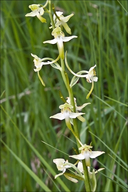|
|
click photo for larger file

Platanthera chlorantha
Greater Butterfly-orchid
|
Photographer: Dr. Amadej Trnkoczy
ID: 0000 0000 1114 1980 (2014-11-13)Copyright © 2014 Dr. Amadej Trnkoczy
|
|
INFORMATION PROVIDED WITH THE PHOTO
|
date of photo Jun 10, 2008
latitude 45.94698 longitude 14.14335
View on Google Maps.
location
Žejna dolina (Thirsty valley) near Hotedrščica village (Notranjska, Slovenia)notes Slo.: zelenkasti vimenjak - Habitat: shallow valley, light mixed wood with dense grassy ground vegetation, half shade, humid place, almost flat terrain, partly protected from direct rain by tree canopies, average precipitations 1.800-2.000 mm/year, average temperature 7-9 deg C, elevation 570 m (1.900 feet), prealpine phytogeographical region. - Substratum: soil. - Protected according to 'Uredba o zavarovanih prostoživečih rastlinskih vrstah' Url. RS, št. 46/2004 (Regulation of protection of wild growing plants, Official Gazette of Republic Slovenia, No.:46/2004). Enlisted in the Slovene Red List of rare and endangered species, marked by 'V' representing a vulnerable species. - Comment: Platanthera chlorantha is essentially a European species with very few disjunct locations in North Africa and Asia. In Slovenia it grows scattered, however, it is less common than it's closely related 'sister' Platanthera bifolia (Lesser Butterfly-orchid). Both plants grow in the same habitats, are more or less whitish-greenish, have two or three large ground leaves and are fragrant and their habitus is also similar. It is not always easy to tell them apart in spite of several detailed differences. The most reliable distinguishing trait seems to be orientation and distance between pollinia. Platanthera chlorantha has pollinia widely separated and they lean in towards each other at the tops while Platantera bifolia has them close together and they are vertical and parallel (see Fig. 5, Platanthera chlorantha right, Platanthera bifola left). The flowers have very long spurs. Not every insect can reach the nectar in them, they have to have very long proboscis. The main pollinators are moths, which are attracted mainly by flowers' smell. Interestingly, widely separated pollinia of Platanthera chlorantha stick their pollen to moths' eyes when they try to protrude with their heads deep into the long spur. Apparently for orientation smell is more important to them than sight? - Ref.: (1) A. Martinči et all., Mala Flora Slovenije, Tehnična Založba Slovenije (1999) (in Slovene), p 998. (2) http://www.first-nature.com/flowers/platanthera-chlorantha.phpcamera Nikon D70 /Nikkor Micro 105mm/f2.8
contributor's ID # Bot_270/2008_DSC9355 photo category: Plant - annual/perennial
|
MORE INFORMATION ABOUT THIS PLANT
|
| common names
Greater Butterfly-orchid (photographer)
View all photos in CalPhotos of Platanthera chlorantha Check Google Images for Platanthera chlorantha |
|
The photographer's identification Platanthera chlorantha has not been reviewed. Click here to review or comment on the identification. |
|
Using this photo The thumbnail photo (128x192 pixels) on this page may be freely used for personal or academic purposes without prior permission under the Fair Use provisions of US copyright law as long as the photo is clearly credited with © 2014 Dr. Amadej Trnkoczy.
For other uses, or if you have questions, contact Dr. Amadej Trnkoczy amadej.trnkoczy[AT]siol.net. (Replace the [AT] with the @ symbol before sending an email.) |
|
|
